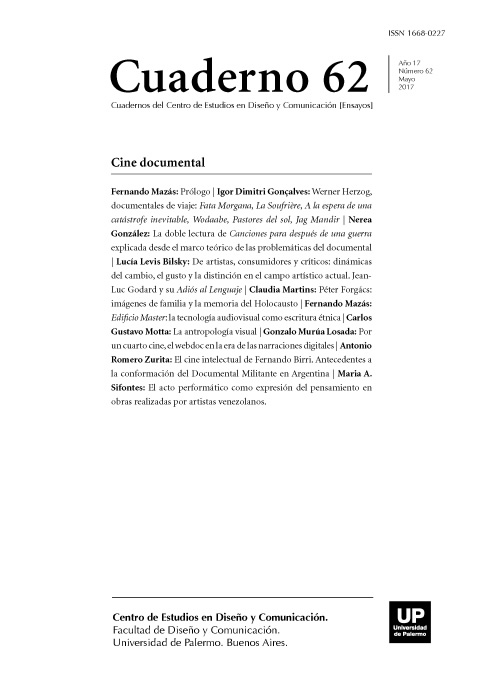Péter Forgács: imágenes de familia y la memoria del Holocausto
Abstract
The article makes a review of the film Bartos Family (1982) by the hungarian film maker Peter Forgács. The analysis focuses in the use of family archives in the making of the film. Forgás uses ancient archives of an hungarian family between 1920 and 1950 showing the day to day of this group and presenting historic facts pre- and post the raising of nazism. The director manipulates the images left in their original context: the hungarian society of those times. The meeting between present audiences with those images from the past produces a new look on history. The paper aims to analyze the film editing techniques applied by the director and the impact of found footage in present audiences.
References
Bernini, E. (2010). “Found footage. Lo experimental y lo documental”, en Leandro Listorti y Diego Trerotola (comps.), Cine encontrado. ¿Qué es y adónde va el found footage?. Buenos Aires: bafici.
Bourriaud, N. (2004). Post producción. Buenos Aires: Adriana Hidalgo. Bonet, E. “Desmontaje documental”, en L. Listorti y D. Trerotola (comps.) Cine encontrado, op. cit.
Farocki, H. (2003). Crítica de la mirada. Buenos Aires: bafici.
Farocki, H. (2013). Desconfiar de las imágenes. Buenos Aires: Caja Negra. Lins, C. y Blank, T. Ruínas da intimidade: os objetos encontrados por Péter Forgács.
Rebello, P. y Sampaio, R. (2012). Péter Forgács. Aquitetura da memoria, CCBB.
Weinrichter, A. (2009). Metraje encontrado. La apropiación en el cine documental y experimental. Navarra: Punto de Vista.
Los autores/as que publiquen en esta revista ceden los derechos de autor y de publicación a "Cuadernos del Centro de Estudios de Diseño y Comunicación", Aceptando el registro de su trabajo bajo una licencia de atribución de Creative Commons, que permite a terceros utilizar lo publicado siempre que de el crédito pertinente a los autores y a esta revista.


